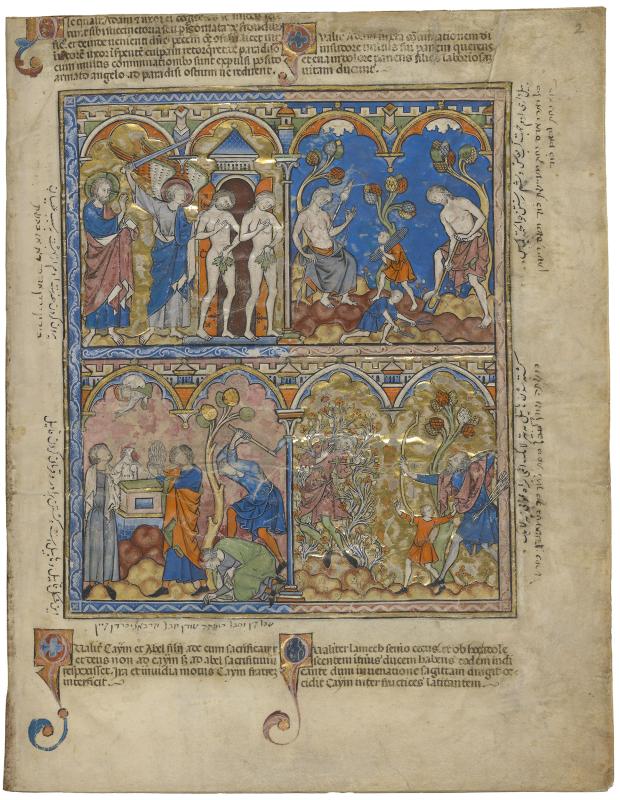
The Expulsion from Paradise, The Trials of Man and Woman, The Sacrifices of Cain and Abel; Cain Murders His Brother, The Death of Cain
Old Testament Miniatures with Latin, Persian, and Judeo-Persian inscriptions
Purchased by J.P. Morgan (1867–1943) in 1916
Folio 2r (Latin)
Upper left: Here is how Adam and his wife, knowing that they were naked, made aprons or perisomata [for the Vulgate’s Greek word penzomata] for themselves of fig leaves and thereafter, having confessed all of their sin at the arrival of the Lord—although the man was casting the blame on the woman and the woman on the snake—were expelled from the garden of Eden with many a threat, an armed angel having been placed at the garden’s gate in order that they might not return. (Genesis 3: 7–24)
Upper right: How Adam, in consequence of the Lord’s threats, seeks bread in the sweat of his face while Eve bears children in pain as they both lead toilsome life. (Genesis 3:19;4:1–2)
Lower left: How when Cain and Abel, Adam’s sons, were making an offering and God had respect not for Cain’s sacrifice but for Abel’s, Cain, driven by anger and jealousy, kills his brother. (Genesis 4:3–8)
Lower right: How Lemech, blind by old age and for that reason having a youth to lead him on his way, while hunting, aimed an arrow, at the youth’s indication, and killed Cain who was hiding in the bushes. (Genesis 4:23 and Historia scholastica, Genesis 28)
Folio 2r (Persian)
Upper left margin: The expulsion of His Excellence Adam [and Eve] from Paradise for [his] rebellion.
Upper right margin: Adam tilling the ground for earning [his] sustenance and Eve spinning wool for clothes.
Lower left margin: This is the image of Abel and Cain and the murder of the brother and the sacrifice of Cain.
Lower right margin: The death of Abel by the arrow of the blind Lamech on the direction of Lamech’s son.
Folio 2r (Judeo-Persian)
Upper left margin, furthest left: Adam’s expulsion from Paradise.
Upper right margin, furthest right: Adam’s having a shovel as a means for his livelihood and Eve’s spinning of wool for clothing.
Lower left, above Latin: [An] image of Cain and Abel, the killing of Abel, and Cain’s [sic!] offering of sacrifice.
Lower right margin, furthest right: Lamech the Blind kills Cain as guided by his [Lamech’s] son.
The Expulsion from Paradise
The disobedient Adam and Eve are expelled from Paradise by the Lord. An angel brandishes a sword over the guilty pair, who now ashamedly hold fig leaves to conceal their nudity. The Gate of Paradise through which the couple exits is depicted as a slender Gothic tower. (Genesis 3:22–24)
The Trials of Man and Woman
After their exile from Eden, the Lord multiplies the sorrows of Adam and Eve. She shall suffer the pains of childbirth; he must cultivate the earth for his bread. As Eve sits spinning with a distaff, Adam digs with a spade. Their sons Cain and Abel collect firewood at their feet. (Genesis 3:16–19)
The Sacrifices of Cain and Abel; Cain Murders His Brother
The Lord is pleased with the ram Abel has brought as a sacrifice, but Cain meets with no such favor for the sheaves he presents at the altar. Furiously jealous, Cain later slays Abel with a hatchet. (Genesis 4:3–8)
The Death of Cain
This scene is drawn from an account popular in the middle ages that expanded upon the brief description of Cain's death in the Book of Genesis. The aged and blind Lamech, his aim guided by a boy, shoots Cain with bow and arrow as he is tangled in a bush. Note that in this and the preceding miniatures, the painter has deliberately ignored some of the plants springing from the ground, perhaps to create a contrast between the barren nature of the world and the lush Garden of Eden. (Genesis 4:15, 23–24)
